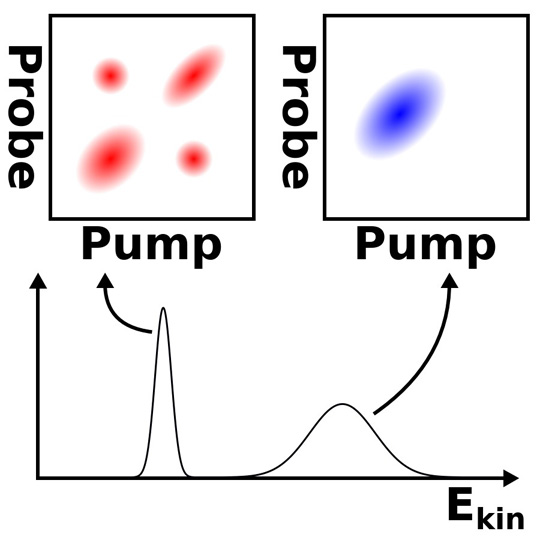New measurement method enables more precise investigation of ultrafast processes in matter
Freiburg, Oct 08, 2021
A team of researchers from Freiburg led by Prof. Dr. Frank Stienkemeier and Dr. Lukas Bruder has succeeded in developing a new measurement method for investigating ultrafast processes in matter. These are processes at the atomic and molecular level that occur within a billionth of a second (10-12 sec). The new method, which combines different spectroscopy techniques, enables, among other things, new insights into the energy structure in matter and the probability distribution of electrons. Fundamental molecular processes can now be understood more precisely, according to the researchers. The results of the research have been published in the scientific journal Optica and are expected to foster a variety of further developments in related scientific fields.
Investigating fundamental properties of matter
The Freiburg team has been working for several years on extending ultrafast, coherent, multidimensional spectroscopy in new directions. Put simply, spectroscopy involves studying the absorption of light in order to investigate important properties of matter. These include the mentioned ultrafast processes, as well as quantum coherence phenomena and interactions between atoms and other nanoscopic particles. “These are the fundamental properties of matter that drive the processes in nature at the nanoscopic level, and we want to better understand these properties through our experiments,” Stienkemeier reports.
A general problem in coherent, multidimensional spectroscopy is the complexity of the measurement data, which often makes a clear interpretation of the experimental results difficult or even impossible. The situation improves significantly when the experiment is combined with the use of, for example, a mass spectrometer. “This approach gives us the additional and very useful information about the chemical composition of the substance under investigation - a major advantage in the study of ultrafast chemical reactions,” Bruder explains.
A host of possibilities
Comparably, the Freiburg researchers have now succeeded in combining coherent, multidimensional spectroscopy with photoelectron spectroscopy. In this procedure, the substance is ionized and the energy of released electrons is measured. This procedure provides information about the energy structure and spatial probability distribution of electrons (orbitals) in matter. When photoelectron spectroscopy is combined with X-ray light sources, precise measurements with atomic selection are even possible, meaning that the energy distribution in a substance can be studied with extremely high resolution up to the atomic level.
"Our approach opens up a variety of exciting new developments," Stienkemeier explains. "This ranges from extending our method for simultaneous energy- and angle-resolved electron measurements, to experiments with X-rays to obtain atom-specific information." As another benefit of the Freiburg approach, the sensitivity of the coherent, multidimensional spectroscopy experiments has been improved by orders of magnitude. That is, signals that were previously a factor of 200 smaller than the noise in the measurement can now be detected. "The increased sensitivity allows us to study very clean samples in an ultra-high vacuum environment from which we can understand fundamental molecular processes more precisely," Bruder adds.
The research project was funded within the framework of the international graduate school “CoCo,” established by the German Research Foundation, and by the European Research Council (ERC) through the project “COCONIS.”
Original publication:
Daniel Uhl, Ulrich Bangert, Lukas Bruder, and Frank Stienkemeier, "Coherent optical 2D photoelectron spectroscopy," Optica 8, 1316-1324 (2021)
DOI: 10.1364/OPTICA.434853

The principle of the developed multidimensional electron spectroscopy: selective multidimensional frequency spectra of the investigated substance can be extracted from the measured kinetic energy distribution of electrons.
Contact:
Prof. Dr. Frank Stienkemeier
Institute of Physics
University of Freiburg
Tel.: 0761/203-7609
E-Mail: stienkemeier@uni-freiburg.de
Bastian Strauch
Office of University and Science Communications
University of Freiburg
Tel.: 0761/203-4301
E-Mail: bastian.strauch@pr.uni-freiburg.de

